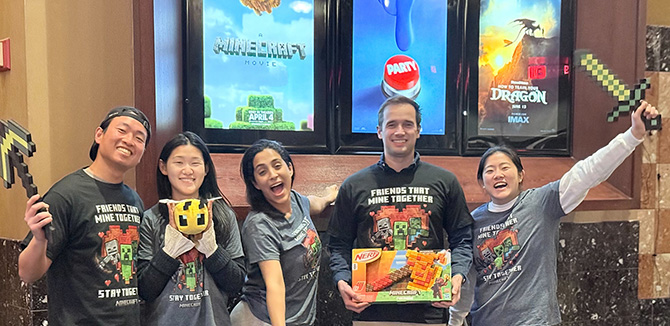Mining for Educational Support
MMM students collaborated with Microsoft to identify how teachers can use Minecraft as an educational assessment tool.

Six words sum up the bond built between Dalal Aldilaimi (MMM ’25), Samantha Lee (MMM '25), Alex Mestre (MMM ‘25), Yutaro Nishiyama (MMM ’25), Dylan Park (MMM '25), and Cicy Zhu (MMM '25).
Friends that mine together stay together.
That message was adorned on T-shirts the students wore to see the Minecraft movie this spring. Yes, they are Minecraft fans, but the experience also was a fitting culmination to their Business Innovation Lab (BIL) project in Northwestern's MBA + MS Design Innovation (MMM) program — a dual-degree program between Northwestern Engineering and the Kellogg School of Management.
Microsoft — the maker of Minecraft — asked the students how to best integrate Large Language Models into student assessments within Minecraft Education. It felt like an ambitious puzzle waiting to be solved.
It also was more than a little confusing.
“I remember our team sitting in a room just staring at each other,” Aldilaimi said. “Someone finally said, ‘Should we start by figuring out what assessment actually means in education?’”
Thus began the students’ immersive BIL journey.
BIL is the culmination of the MMM experience and pairs student teams with leading global organizations to solve real-world business problems. This student team’s research focused on the ways educators currently evaluate students and how Minecraft could enhance 21st-century skills — collaboration, creativity, and reflection — in ways traditional methods don’t.
“The platform’s strength lies in providing a shared virtual world where students communicate and make collective decisions,” Nishiyama (MMM ’25) said. “This dynamic mirrors real-world collaborative scenarios.”
Through interviews with high school teachers, the team realized that while educators valued these skills, they lacked effective tools for assessment. The team’s final prototype allowed LLMs to analyze student interactions within the game, offering nuanced feedback on teamwork and communication.
The journey wasn’t without obstacles. Midway through the project, the group struggled to transform conceptual ideas into a tangible solution within Minecraft.
“We invested a significant amount of time in deeply understanding the core insights,” Nishiyama said. “In hindsight, it was a valuable process, but it left us with a compressed timeline for actual implementation.”
Rapid prototyping proved essential. The iterative design approach reinforced a lesson the students had encountered throughout the MMM program: Design is far from linear and often very messy.
“Watching these talented students navigate through continuous rounds of building and iterating together was a joy," said Amy O'Keefe, who served as the group's faculty advisor. "They combined genuine curiosity with rigorous research and persistence, showing how powerful design thinking can be in transforming abstract ideas into meaningful solutions.”
Park said the Minecraft experience drove home that lesson even further and that he learned first-hand that the best solutions often emerge after multiple rounds of rethinking and redesign.
When educators tested the final prototype, skepticism gave way to excitement. Within minutes of play, teachers began to see AI’s potential in action, Nishiyama said.
For the student team, the project reinforced the value of learning by doing.
“We brought up concepts from our classes all the time,” Aldilaimi said. “Professor Gina Fong’s ethnography methods, RDB’s ‘How Might We’ framework — everything clicked.”
For Microsoft, the collaboration was invaluable.
“MMM’s focus on design, strategy, and creativity made it a natural partner for this challenge,” said Justin Edwards, director of learning experiences for Minecraft at Microsoft. “The students impressed us with their professionalism and ability to turn complex ideas into real-world solutions.”
As the students near graduation, they carry forward insights from their BIL experience that will shape their careers. Whether launching EdTech ventures or entering consulting, the lessons learned — from navigating team dynamics to leading innovation — will endure, the students said.
“We went from not knowing what the assignment was even asking to creating something that could actually be useful to Microsoft, which still blows my mind a little,” Aldilaimi said. “The way we structured our team, the care we showed, the feedback we gave — I want to carry that with me forever.”
